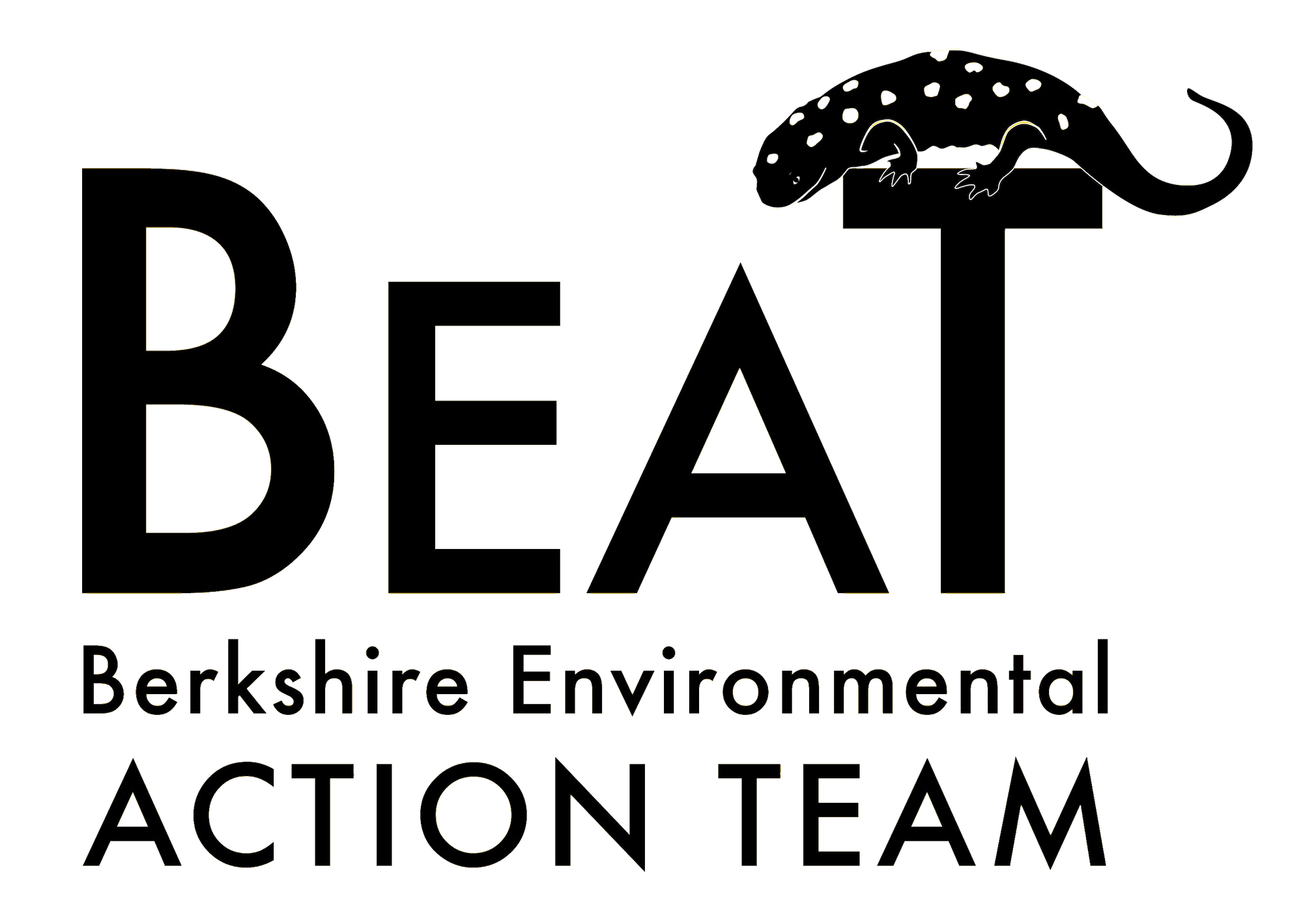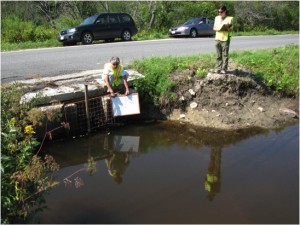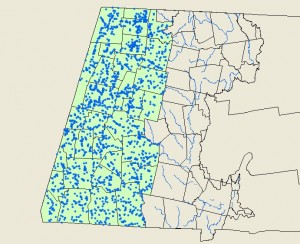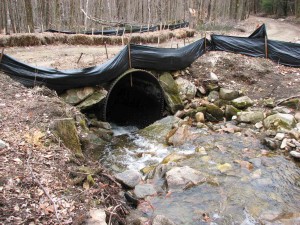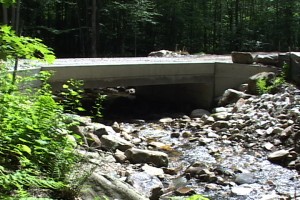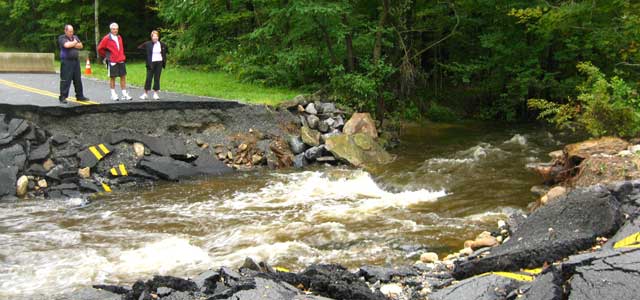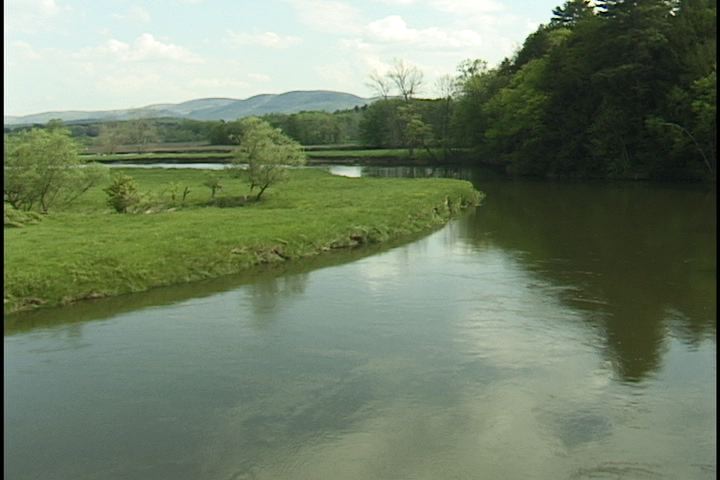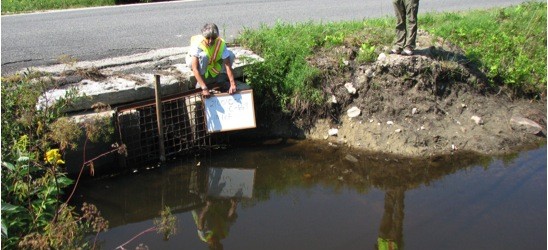
BEAT Surveys Stream-Crossings
Some people look at road construction as an inconvenience – a traffic delay, or a detour. BEAT looks at road construction as an opportunity. It started with efforts by the state to remove dams from our streams and rivers. Free-flowing waterways provide better habitat for many wildlife species – especially cold-water fish species. One problem with dams is that they are obstructive. They are an obstacle to the free upstream or downstream movement of fish and other creatures living in the water.
Well it turns out that so are many culverts – those concrete, metal, or plastic pipes or other conduits that carry water under roadways. Look at the picture below.
This culvert may not look like it poses a threat to wildlife, but imagine you’re a small fish, or insect larva, or amphibian trying to get up this stream. This might as well be Niagara Falls in front of you.
Another problem with many of our culverts is that they are just too small for the task. (BEAT recently videotaped three presentations on this topic.) When an undersized culvert is installed under a roadway, the water may pass through just fine 90% of the time. But what happens in times of high water? When a culvert is too small to handle the amount of water trying to pass through it, the excess water has to go somewhere. Often it goes around the culvert and up onto the roadway. Sometimes the excess water squeezes between the culvert and the soil, following the outside of the culvert instead of the inside. This erodes the soil under the roadway and can cause safety issues.
Another less obvious problem related to undersized culverts is that they restrict the flow of nutrients. Headwaters – the small streamlets and brooklets that are the source of our watersheds – provide most of the nutrients in the water and in the sediments. Leaves, dying insects and other natural material collect and decay in the water, adding organic nutrients as streams begin their flow toward the ocean. Unnatural constrictions in a streambed can result in restricted downstream flow of these nutrients.
So what does this have to do with road construction, and what does this have to do with BEAT? Well, BEAT is currently surveying all stream crossings in Berkshire County – all places where a roadway crosses a stream. There are a lot of them. The estimate is that there are about 2,100 of these crossings in the county, but we can’t be sure, although as the survey progresses we’ll know more.
BEAT’s volunteers, interns, and partners are surveying these crossings as part of a project organized by the University of Massachusetts, The Nature Conservancy, and the Massachusetts Division of Ecological Restoration (formerly Riverways). BEAT is currently partnering with The Housatonic Valley Association and the Hoosic River Watershed Association (Hoorwa) in surveying stream crossings in Berkshire County. BEAT is also working with other groups surveying stream crossings in the Farmington, Westfield, and Deerfield River watersheds who will share their data on crossings where those watersheds extend into Berkshire County.
If you would like to volunteer to help surveying crossings, please contact Alison Dixon with Housatonic Valley Association for more information.
In addition to surveying stream crossings, BEAT will be entering data collected by all these groups into a state-wide database maintained by UMASS, and has created an in-house database that includes hyperlinks to photos of each crossing and useful statistics recorded by the survey teams.
All of the information collected in this program is useful to a number of groups and for a number of purposes, but one use that especially interests BEAT is the use being made of this data by MassDOT (the Massachusetts Department of Transportation.)
The University of Massachusetts, The Nature Conservancy, and the Massachusetts Division of Ecological Restoration have created a set of standards for designing culverts. These standards have been adopted into the regulations of the MassDOT and the Army Corps of Engineers. The standards ensure that culverts will not create artificial waterfalls that hinder aquatic migration. They will also be open-bottomed wherever possible so that the substrate within the culvert matches the substrate of the streambed. Culverts must be wider than the actual streambed. Specifically, culverts must be 1.2 times the width of the streambed. This extra width, which will be dry except in times of very high water, provides a path for non-aquatic wildlife such as raccoons, mink, porcupines, and in some of the larger waterways, deer and bear. There are also other guidelines within the new regulations. The idea is that a fish swimming upstream should not notice any difference in the stream when it swims under the road, other than a passing shadow. Check out these two “before” and “after” pictures taken in Windsor.
Under these new regulations, municipalities that are doing roadwork that involves a culvert are encouraged to replace the culvert with one that meets these new standards. Municipalities are not being made to dig up roadways just to upgrade deficient culverts, but if they are replacing a culvert, they must replace the existing culvert with one that meets the new standards. Because of the stream-crossing survey, each road construction project that involves a culvert becomes an opportunity for improvement in wildlife movement, habitat connectivity, and public safety. Culverts that meet all of these guidelines will allow easier migration and movement of aquatic and terrestrial wildlife, which is especially important in this time of climate change.
Here’s a link to a funny video that shows just how much of a pain in the neck a perched culvert is to a fish. Enjoy!
